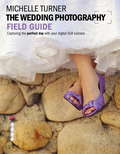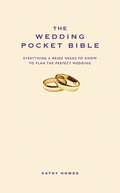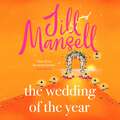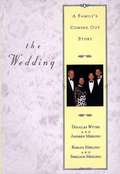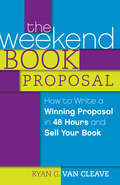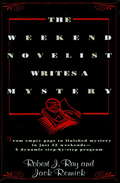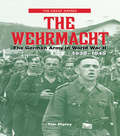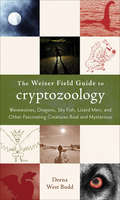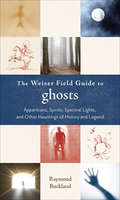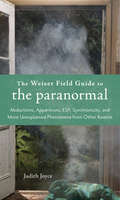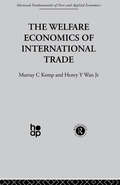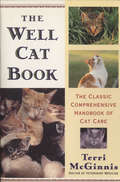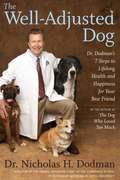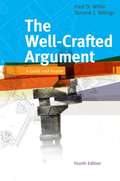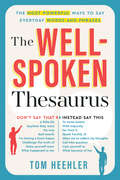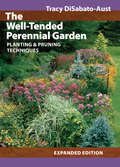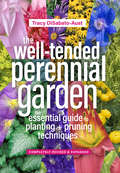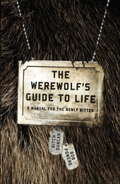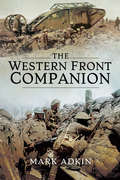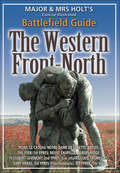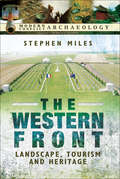- Table View
- List View
The Wedding Photography Field Guide: Capturing the Perfect Day with your Camera (Field Guide Ser.)
by Michelle TurnerLong gone are the days of lining up the wedding party for predictable and overly-staged group shots. Now more than ever, couples want to remember their wedding day - and the run up to it - with candid, photojournalistic-style photos and innovatively-designed albums.The Wedding Photography Field Guide is a source of inspiration and illumination, and sets out how to capture the true essence and atmosphere of this emotionally-charged and very special day.- Get the latest information on digital gear and a professional's take on top techniques for covering all the action.- Stuffy, staged wedding photos are a thing of the past. Master modern wedding reportage and capture the true spirit of the event and the personalities of the couple and guests.- Discover the secrets of creating uniquely personal and contemporary bridal portraits and albums.- Don't get left behind in this competitive marketplace. Follow Michelle Turner's advice and build up a portfolio that can pack a punch.- Whether you are simply shooting a friend's wedding, breaking into the business or looking to refresh your approach, this book is essential.
The Wedding Pocket Bible
by Cathy HowesThis is the perfect present for a bride-to-be.Getting engaged is a cause for celebration, but with it comes the exciting, and daunting task of planning the wedding day, as well as preparing yourself for marriage!The Wedding Pocket Bible gives you all the essential advice and information you'll need, including the traditions and wedding etiquette; from invitations and table plans to bridesmaids', best man, mother-of-the-bride and the groom's duties.We also bring you bridal tips and advice to help you enjoy planning the big day. We've covered everything you might possibly need to know, in this beautifully packaged gift book, including: weddings on a budget, choosing the right venue for you, personalising your wedding, planning your stag and hen dos, choosing your cake, flowers, music, photographer, and of course, the important dress.Above all, this book will make sure you and your future husband have the wedding you want, and will remember forever.
The Wedding Pocket Bible
by Cathy HowesThis is the perfect present for a bride-to-be.Getting engaged is a cause for celebration, but with it comes the exciting, and daunting task of planning the wedding day, as well as preparing yourself for marriage!The Wedding Pocket Bible gives you all the essential advice and information you'll need, including the traditions and wedding etiquette; from invitations and table plans to bridesmaids', best man, mother-of-the-bride and the groom's duties.We also bring you bridal tips and advice to help you enjoy planning the big day. We've covered everything you might possibly need to know, in this beautifully packaged gift book, including: weddings on a budget, choosing the right venue for you, personalising your wedding, planning your stag and hen dos, choosing your cake, flowers, music, photographer, and of course, the important dress.Above all, this book will make sure you and your future husband have the wedding you want, and will remember forever.
The Wedding of the Year: the heartwarming brand new novel from the No. 1 bestselling author
by Jill MansellThe irresistible, romantic, heart-warming new novel from the beloved author of Promise Me, Jill Mansell. 14 million books sold worldwide!PRE-ORDER the riveting audiobook from the queen of the feelgood romcom!Love, friendship and secrets revealed as the sun beats down on dazzling blue Cornish seas . . .It's set to be the perfect wedding - till the chauffeur is asked to keep driving the bride round the church. This wedding is not going as planned.Lottie is a guest at the wedding when she sees Max for the first time in fifteen years. No kiss since has matched their last kiss together. They were on the brink of a beautiful love story. Then something shocking happened that tore them apart. Now here he is, handsome as ever, teasing Lottie in the old way - and that tingling electric attraction is back. But Max is out of bounds.Ruby has been the perfect vicar's wife. But when she finds out the truth about her husband Peter, outrage and disbelief drive her to act impulsively, without a thought for the consequences. And nothing will ever be the same again.There will be a wedding of the year - but maybe not yet. When love is in the air, anything can happen . . .The gorgeous new romance from the beloved and bestselling Jill Mansell!Praise for Jill's novels'A real ray of sunshine and - exactly what's needed right now - Jill's books should be on prescription!' Phillipa Ashley'The absolute definition of "reading for pleasure", it will bring hours of happiness' Veronica Henry 'Jill Mansell's brilliance shouts from every page' Milly Johnson(P)2024 Headline Publishing Group Ltd
The Wedding: A Family's Coming Out Story
by Douglas Wythe Andrew Merling Roslyn Merling Sheldon Merling<p>Two people meet and fall in love. Over time, their relationship grows and they decide to spend the rest of their lives together. They plan a wedding, a formal binding into a permanent relationship with family and friends on hand as witnesses to solemn but beautiful vows. It's an occasion people dream about for most of their lives, though it is often joked that the wedding is more for the parents than the children. <p>But what if they''re gay? Andrew Merling was a graduate student in clinical psychology when he met Doug Wythe, a television promotion director. Their relationship continued for three-and-a-half years before Doug formally proposed marriage to Andrew. Together, they agreed to have a traditional affair for family and friends. While Doug was not as close to his extended family, Andrew came from large, tight-knit Jewish family in Montreal. When he announced his engagement and the couple's plans for a traditional Jewish ceremony and a festive celebration, it was then that previously unacknowledged prejudices and hidden concerns suddenly reared their contentious heads. Typical wedding conflicts over money and manners paled next to worries over whether Andrew''s parents would find themselves ostracized by their conservative community. <p>Then, just two months before the big day, the family had to decide if they were ready to perform the ultimate act of "coming out," when ABC-TV News asked to profile them as part of an episode on Turning Point, and bring national attention to their personal struggle. The first book to speak to both sides of a controversy that is altering our society, this fascinating chronicle follows Doug, Andrew, and his parents Sheldon and Roslyn on the rocky road from engagement to understanding. With the impending wedding as a catalyst, they embark on a painful, joyful odyssey of discovery, struggling both to be heard and to find acceptance from each other, their friends and communities. Their four distinct voices blend to create a unique depiction of one family coming to grips with the reality of being a gay couple in today's world.</p>
The Weekend Book Proposal: How to Write a Winning Proposal in 48 Hours and Sell Your Book
by Ryan G. Van CleaveWrite Better Proposals Faster to Accelerate Your Writing Career! Whether you are a true beginner or a seasoned writer looking to secure more book contracts, The Weekend Book Proposal shows you how to take your best ideas and create powerful proposals--quickly and professionally. No need to spend months laboring over a proposal when in just a few days you can write one that will ignite the interest of agents and editors. Ryan G. Van Cleave presents the tools you need to craft an eye-grabbing proposal for your nonfiction, memoir, anthology, textbook, novel, and more. Jam-packed with proven strategies, nuts-and-bolts advice, sample queries and proposals, interviews with publishing experts, and "Hit the Gas" tips for speeding up the proposal process, The Weekend Book Proposal will show you how to succeed and prosper as a writer--and sell your books before you've even written them! The Weekend Book Proposal explains how to: Write a catchy title and book description. Create a compelling author bio and chapter outline. Develop a targeted, engaging concept statement. Build a strong marketing plan and endorsements list. Structure your proposals based on those crafted by successful authors.
The Weekend Novelist Writes a Mystery
by Robert J. RayLike Agatha Christie and Raymond Chandler, Sara Paretsky and Thomas Harris, you, too, can learn the trade secrets of quality detective fiction.It's true. Just one year from now, you can deliver a completed mystery novel to a publisher--by writing only on weekends. Authors Robert J. Ray and Jack Remick guide you through the entire mystery-writing process, from creating a killer to polishing off the final draft. Each weekend you'll focus on a specific task--learning the basics of novel-writing, the special demands of mystery-writing, and the secrets professionals use to create stories one scene at a time, building to a shivery, satisfying climax. Using Agatha Christie's The Body in the Library as a model for the classical mystery tale and Martin Cruz Smith's Gorky Park for the hard-boiled mystery, this unique step-by-step program gives you all the information you need to reach your ultimate goal: a finished book in just 52 weeks! Let two successful masters of the genre show you how...Discover: Why you must create your killer first The tricks to writing dialogue that does it all--moves your plot, involves your reader, and makes your style sizzle How to "bury" information (and corpses) for your reader to find Why you should NOT build your book around chapters Special techniques for clearing writer's block Plus: examples from Sue Grafton, Dashiell Hammett, Patricia Cornwell, Thomas Harris, Raymond Chandler, and more.From the Trade Paperback edition.
The Wehrmacht: The German Army in World War II, 1939-1945
by Tim RipleyTo see the foreword, the introduction, a generous selection of sample pages, and more, visit the website The Wehrmacht website.In this unique volume, expert Tim Ripley introduces the reader to the world of the German army, covering in detail concepts such as mobile defense and the formidable Blitzkrieg, and explains why the Wehrmacht was able to fight so long, with such fearsome effectiveness. Also includes 180 color and black and white maps and illustrations.
The Weiser Field Guide to Cryptozoology: Werewolves, Dragons, Skyfish, Lizard Men, and Other Fascinating Creatures Real and Mysterious (The Weiser Field Guide)
by Deena West BuddA study of dozens of hidden animals—from the chupacabra to Mongolian death worms—drawing on eyewitness accounts from around the world. This informative book includes information, interviews, and stories about forty different cryptids seen around the world by credible eyewitnesses like policemen, rangers, and doctors. Readers will learn where and how to find flying humanoids, hairy humanoids, giants of all kinds including rabbits, bats, and spiders, goblins, vampires, werewolves, demons, aliens, and ghosts. Cryptozoology—a term coined in the 1950s by a French zoologist named Bernard Heuvelmans—is the study of hidden or unknown animals not recognized in standard zoology. From traditional cryptids like Big Foot, the Abominable Snowman, and Nessie, to mythical cryptids like unicorns, vampires, dragons, and werewolves, to lesser-known cryptids like bunyips (waterhorses), Encantado (Dolphin Men of Brazil), thunderbirds, mothmen, and chupacabra, these creatures are very much alive, says expert Deena West Budd, if beyond the realm of normal perception. The Weiser Field Guide to Cryptozoology includes a brief history of the field and surveys all the creatures for which any credible amount of research exists—as well as giving tips on how to spot these creatures and cautionary advice on how to interact with them. Includes two dozen line drawings rendered from eyewitness descriptions
The Weiser Field Guide to Ghosts: Apparitions, Spirits, Spectral Lights and Other Hauntings of History and Legend (The Weiser Field Guide)
by Raymond BucklandA reference guide to the otherworld—includes illustrations. From battlefield and biblical ghosts to poltergeists and orbs, The Weiser Field Guide to Ghosts examines categories and subcategories of ghosts across time and cultures, including commonalities and misconceptions. Stories of encounters, legendary ghosts, and haunted places are all covered in this beautifully illustrated compendium, a veritable A-Z of the otherworld. The Weiser Field Guide to Ghosts is concise and comprehensive—and also includes practical tips on ghost hunting and suggested further reading.
The Weiser Field Guide to the Paranormal: Abductions, Apparitions, ESP, Synchronicity, and More Unexplained Phenomena from Other Realms (The Weiser Field Guide)
by Judith JoyceAn A-to-Z resource on paranormal phenomena, with illustrations. Stranded motorists on a lonesome road are rescued by angels. The phone rings with a call from beyond the grave. A blood-sucking predator is sighted in the south of Texas. The Weiser Field Guide to the Paranormal is your gateway into the world beyond the known. Covering topics from cryptids to psychics, telekinesis to telepathy, this concise, alphabetized handbook will guide you through the eerie, the undeniable, and the strange world of the paranormal. Once upon a time, events like ghost sightings were commonplace. Parlors were redecorated to accommodate seance rituals, and ghost stories poured from the culture. Psychic occurrences and abilities might have been feared and disliked, but they were accepted as a normal part of life. Today, we are experiencing a resurgence of all things paranormal. Join paranormal investigator and psychic Judith Joyce as she delves into this world with haunting detail and illuminating clarity. Joyce touches on all of the major aspects of paranormal phenomena, and more. Do you have telepathic powers? Can the Ouija board really speak from the Other Side? Use this paranormal primer to find out.
The Welfare Economics of International Trade (Fundamentals Of Pure And Applied Economics Ser.)
by M. Kemp H. WanThis book provides a careful account of the leading propositions about the welfare gains associated with international trade and investment under differing institutional arrangements and policy choices.
The Well Cat Book: The Classic Comprehensive Handbook of Cat Care
by Terri McginnisFeaturing sections on daily care, preventive medicine, and training, The Well Cat Book teaches cat owners how to detect signs of illness, diagnose problems, and begin home treatment--thereby avoiding expensive and often unnecessary trips to the vet. Includes over 100 illustrations and step-by-step instructions.From the Trade Paperback edition.
The Well-Adjusted Dog: Dr. Dodman's 7 Steps to Lifelong Health and Happiness for Your Best Friend
by Dr. Nicholas H. DodmanOne of the greatest myths in dog ownership is that once a puppy is housetrained and has graduated from a puppy training class, an owner’s work is done. In fact, that work is just beginning.Drawing on some twenty-five years of clinical experience, Dr.Dodman offers what he calls "continuing education" for dogs and their owners. You will discover • how much exercise your dog really needs (and why) • how diet can affect behavior • how to communicate clearly with your dog and understand dog body language • how to lead your dog, not dominate him • how to optimize your dog’s environment • how to address medical problems that might underlie unwanted behavior Dr.Dodman’s comprehensive, seven-step approach takes on the whole dog—his health, behavior, and environment—and lays the groundwork for the proper care and training of your best friend, for life.
The Well-Crafted Argument: A Guide and Reader
by Fred D. White Simone J. BillingsThe Well-Crafted Argument equips students with a comprehensive set of skills necessary for writing argumentative essays in a wide variety of contemporary social contexts. Based on a process pedagogy that encourages individual voice and vision, the book introduces models of good writing for inexperienced writers. Divided into two parts, a rhetoric and a reader, it provides instructors and students with a wealth of materials and tools for effective argumentative writing, thinking, and reading.
The Well-Crafted Argument: A Guide and Reader (4th Edition)
by Fred D. White Simone J. BillingsIncorporating new articles, expanded commentary, and the latest changes from the 2009 MLA Handbook and 2009 APA Publication Manual, the 4th Edition of THE WELL-CRAFTED ARGUMENT guides students through the process of writing effective arguments across the disciplines. The two-part structure of this rhetoric/reader includes a complete pedagogical apparatus--with coverage of critical reading strategies, as well as writing, researching, and documenting a topic--and an anthology of readings grouped into nine thematic clusters. In-depth instruction, combined with real student writings, engages students and helps them discover their own voices. The Fourth Edition continues the visual emphasis from the 3rd Edition, while maintaining the authors' practical, skill-building approach. Each chapter in Part I ends with a "Summary," "Checklist," and "Writing Projects," while each cluster in Part II ends with "Connections Among the Clusters," "Writing Projects," and "Suggestions for Further Reading. " These sections encourage students to apply what they've learned and go beyond the classroom if a topic is of particular interest to them. In addition to guidance on drafting and revising arguments, the authors provide a variety of composition strategies, including freewriting, outlining, and shared reading.
The Well-Spoken Thesaurus: The Most Powerful Ways to Say Everyday Words and Phrases
by Tom HeehlerThe Well-Spoken Thesaurus is designed to help you improve your communication skills by expanding your vocabulary.The book includes over 200 words, arranged in easy-to-use categories, such as "positive emotions," "negative emotions," "intellectual terms," and "descriptive terms." Each entry includes a definition, synonyms, antonyms, and usage examples. The Well-Spoken Thesaurus is particularly useful for writers who want to improve the precision and impact of their language. By providing a range of synonyms for common words and phrases, the book helps writers avoid repetition and clichés, while also encouraging them to use language that is more vivid, specific, and memorable.Some of the benefits of using The Well-Spoken Thesaurus include:Making a stronger impression: By choosing words that are more precise and impactful, you can help your writing stand out from the crowd and make a stronger impression.Demonstrating your communication skills: Using a wide range of vocabulary can demonstrate that you are articulate, sophisticated, and able to communicate effectively.Conveying your personality: Includes a range of descriptive terms that can help you convey your personality and character traits in your writingOverall, The Well-Spoken Thesaurus can be a valuable resource for anyone who wants to improve their writing and communication skills.
The Well-Tempered Sentence: A Punctuation Handbook for the Innocent, the Eager and the Doomed
by Karen Elizabeth GordonEverything you ever wanted to know about punctuation marks using humorous examples.
The Well-Tended Perennial Garden: Planting & Pruning Techniques
by Tracy DiSabato-AustWith more than 180,000 copies sold since its original publication, The Well-Tended Perennial Garden has proven itself to be one of the most useful tools a gardener can have. Now, in this expanded edition, there's even more to learn from and enjoy. This is the first, and still the most thorough, book to detail essential practices of perennial care such as deadheading, pinching, cutting back, thinning, disbudding, and deadleafing, all of which are thoroughly explained and illustrated. More than 200 new color photographs have been added to this revised edition, showing perennials in various border situations and providing images for each of the entries in the A-to-Z encyclopedia of important perennial species. In addition, there is a new 32-page journal section, in which you can enter details, notes, and observations about the requirements and performance of perennials in your own garden. Thousands of readers have commented that The Well-Tended Perennial Garden is one of the most useful and frequently consulted books in their gardening libraries. This new, expanded edition promises to be an even more effective ally in your quest to create a beautiful, healthy, well-maintained perennial garden.
The Well-Tended Perennial Garden: The Essential Guide to Planting and Pruning Techniques, Third Edition
by Tracy DiSabato-Aust“This practical guide is lush with clear, step-by-step advice.” —Real Simple Since its original publication twenty years ago, The Well-Tended Perennial Garden has helped home gardeners successfully plan, plant, and tend their gardens. Now Tracy Di-Sabato-Aust’s trusty advice and reassuring tone are back and better than ever in this completely revised new edition. Novice and experienced gardeners alike will benefit from Tracy’s thorough details on the essential practices of perennial care—included deadheading, pinching, and thinning—along with growing information for new species and cultivars, on-trend garden design advice, a monthly planting and maintenance schedule, and details on native plants and gardening for wildlife. The Well-Tended Perennial Garden is a must-have ally in the quest for a beautiful, well-maintained garden.
The Werewolf's Guide to Life
by Ritch Duncan Bob PowersHave you been attacked by a wolf-like creature in the last 30 days? Was it after the sun had set and under a full moon? If you answered, "yes" to both these questions, there's a very good chance that you were bitten by a werewolf. You now have less than a month before the full moon returns and with it your first transformation into a savage, bloodthirsty beast. Survival is an option, but first, know this:* Werewolves are real.* The majority of lycanthropes who do not have access to this book die during or shortly after their first transformations, generally due to heart failure, gunshot wounds, exposure, drowning or suicide. * Hollywood horror movies are NOT to be used as guides to living as a werewolf. Their goal is not to educate, but to entertain. As a result, they are largely ignorant of the realities of the condition.* Ignorance creates monsters; lycanthropy does not. * You are not a monster.The Werewolf's Guide to Life cuts through the fiction and guides you through your first transformation and beyond, offering indispensable advice on how to tell if you're really a werewolf, post-attack etiquette, breaking the news to your spouse, avoiding government abduction, and how to not just survive, but thrive. You cannot afford to not read this book. Your very life depends on it.From the Trade Paperback edition.
The Werewolf's Guide to Life: A Manual for the Newly Bitten
by Ritch Duncan Bob PowersHave you been attacked by a wolf-like creature in the last 30 days? Was it after the sun had set and under a full moon? If you answered, yeso to both these questions, there's a very good chance that you were bitten by a werewolf. You now have less than a month before the full moon returns and with it your first transformation into a savage, bloodthirsty beast. Survival is an option, but first, know this: * Werewolves are real. * The majority of lycanthropes who do not have access to this book die during or shortly after their first transformations, generally due to heart failure, gunshot wounds, exposure, drowning or suicide. * Hollywood horror movies are NOT to be used as guides to living as a werewolf. Their goal is not to educate, but to entertain. As a result, they are largely ignorant of the realities of the condition. * Ignorance creates monsters; lycanthropy does not. * You are not a monster. The Werewolf's Guide to Life cuts through the fiction and guides you through your first transformation and beyond, offering indispensable advice on how to tell if you're really a werewolf, post-attack etiquette, breaking the news to your spouse, avoiding government abduction, and how to not just survive, but thrive. You cannot afford to not read this book. Your very life depends on it.
The Western Front Companion: The Complete Guide To How The Armies Fought For Four Devastating Years, 1914-1918
by Mark AdkinThe definitive guide to the main theater of WWI—&“maps of the battles . . . military strategy . . . extraordinary anecdotes . . . it&’s a triumph&” (Daily Mail). Written by the author of the three previous bestselling Companions on Waterloo, Trafalgar and Gettysburg—now acclaimed as the definitive work of reference on each battle—The Western Front Companion is not a mere chronological account of the fighting. Rather, it is an astonishingly comprehensive and forensic anatomy of how and why the armies fought, of their weapons, equipment and tactics, for over four long and bloody years on a battlefield that stretched from the Belgian coast to the Swiss frontier—a distance of 450 miles. Alongside the British Army, full coverage is given to Britain&’s allies—France, Belgium, Australia, New Zealand, Canada, South Africa, India and the United States—as well as the Germans. The 350,000 words of text range over everything from the railways on the front to the medical corps and the chaplains. Like previous Companions, this book is equally distinguished by its magnificent visual resources—original and intricate maps and diagrams, over 200 resonant and remarkable archive images from the time (many rarely seen), and modern color photographs showing how historic battlefields look nowadays, and paying tribute to the magnificent and poignant cemeteries, monuments and ossuaries that mark the fallen for today&’s battlefield visitor. Every reader, no matter how well informed already on the history of World War I, will learn something new from this extraordinary and exhaustive volume. No one interested in the true story and sheer sweep of the Great War on the Western Front can afford to be without it.
The Western Front-North: 100th Anniversary Edition (Major & Mrs Holt's Concise Illustrated Battlefield Guide)
by Tonie Holt Valmai HoltFollowing in their best-selling series of Battlefield Guides this is a companion volume to the Holts Western Front South Guide. Between the two, they cover the main WW1 Western Front battlefields. This book covers 15 of the most significant battles of the northern area from Nieuwport to just north of The Somme.Whether travelling on the ground or in the mind, the reader is carefully guided through the battlefields with a mixture of succinct military history, cameo memories and stories of VCs and other personalities, interspersed with references to the literature and poetry of the war.This guidebook is based on Tonie and Valmai Holt's 30 years experience of researching, guiding tours and writing about the area, with their unique blend of male and female points of view. It is written to the high standards that have come to be expected of these highly respected authors who are credited with pioneering the modern battlefield tour and whose guide books are referred to as 'The Bibles' . This new edition contains: Brief Historical Background and Summary of each battle, Opening Moves and What Happened, with appropriate quotations Sketch Map for each battle showing battle lines, routes etc and all points of interest described on each timed itinerary Large Sketch Map putting the battlefields (north and south) into perspective Memorials, Museums, Sites of Interest (bunkers, craters etc) War Grave Cemeteries Allied and German GPS Location for every recommended stop War Graves and Commemorative Associations Cameos about individual personalities Useful Tourist Information Where to stay and eat
The Western Front: Landscape, Tourism and Heritage (Modern Conflict Archaeology)
by Stephen MilesThe Western Front has become, once again, and after 100 years, an important and increasingly popular tourist destination. The Centenary is already encouraging large numbers of visitors to engage with this highly poignant landscape of war and to commemorate the sacrifice and loss of a previous generation. Interest is also being sharpened in the places of war as battle-sites, trench-systems, bunkers and mine craters gain a clearer identity as war heritage. For the first time this book brings together the three strands of heritage, landscape and tourism to provide a fresh understanding of the multi-layered nature of the Western Front. The book approaches the area as a rich dynamic landscape which can be viewed in a startling variety of ways: historically, materially, culturally, and perceptually. To illustrate these two dominant interpretations of the regions landscape commemorative and heritage are highlighted and their relationship to tourism explored. Tourism is a lens through which these layers can be peeled away, and each understood and interacted with according to the individuals own knowledge, motivation, and degree of emotional engagement. Tourism is not regarded here as a passive phenomenon, but as an active agent that can determine, dictate and inscribe this evocative landscape. The Western Front: Heritage, Landscape and Tourism is a timely addition to our increasing interest in the First World War and the places where it was fought. It will be indispensable to those who seek a deeper understanding of the conflict from previously undervalued perspectives.
